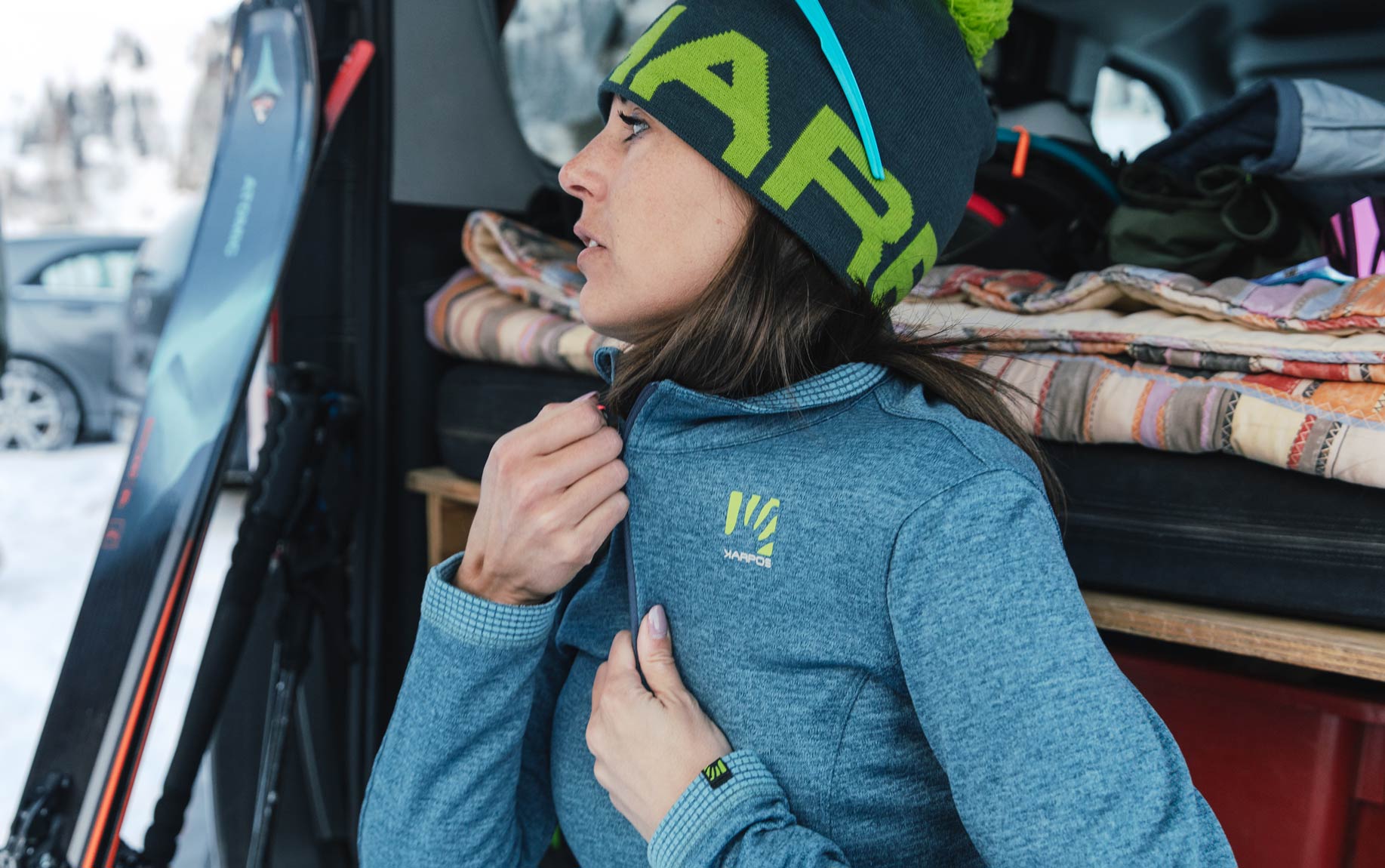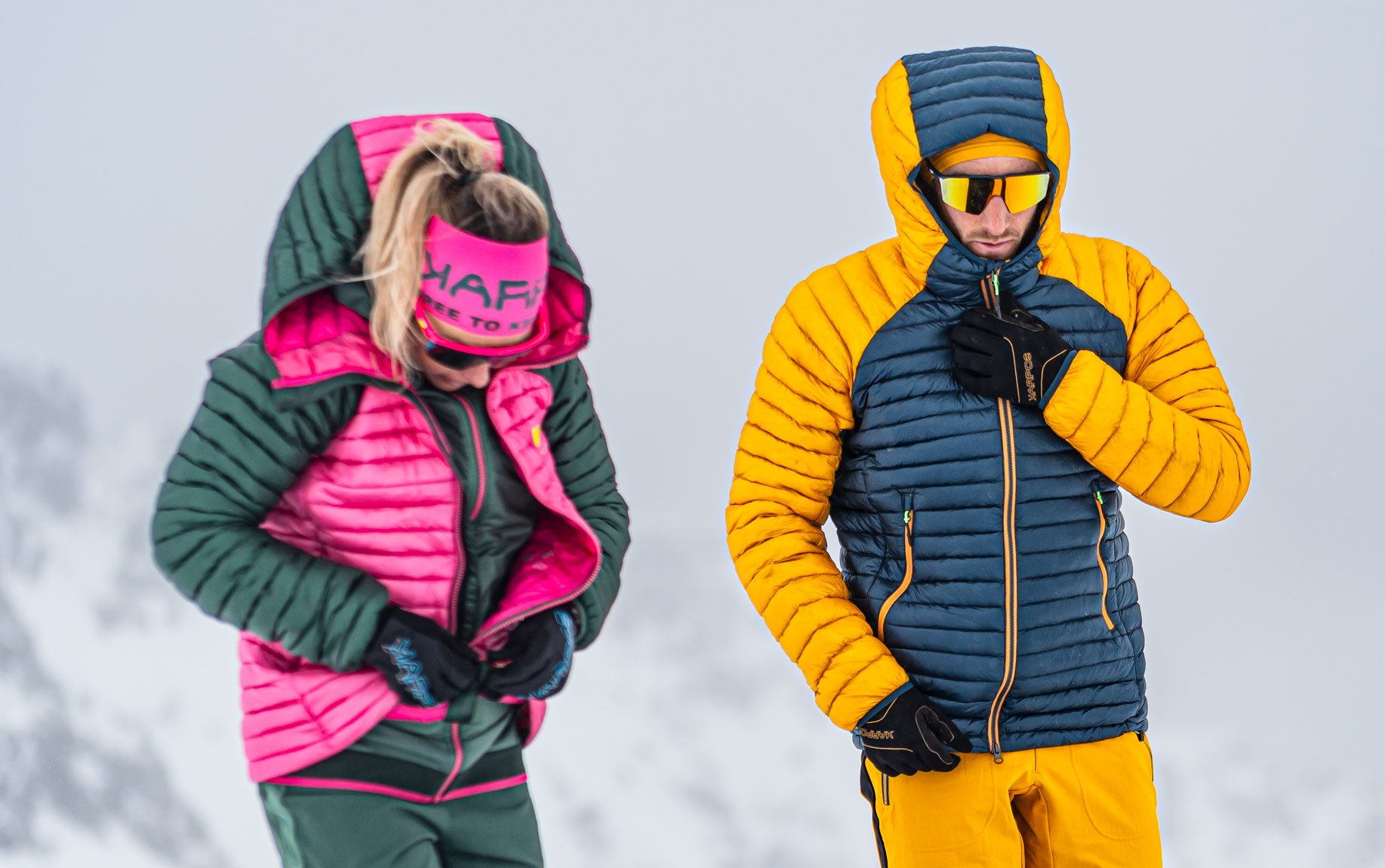PRODUCT CARE

PRODUCT CARE
Taking care of your outdoor clothing means extending its life while at the same time reducing environmental impact through appropriate washing and drying.
By following these simple step-by-step instructions, tested on our technical garments and broken out based on the product’s primary material, you can optimize the consumption of resources such as water and energy, reduce the quantity of microplastics and chemical substances released into waterways, and extend the use and performance of your favorite products for as long as possible.
Feel free to submit any questions about product care or report any unexpected results by contacting customer service at service@karpos-outdoor.com.
Together we can help reduce the environmental impact of technical garments.
1. ALL TECHNICAL GARMENTS

1.1. The first step in making your favorite garments last as long as possible is to store them properly between uses, by placing them on a hanger inside a closet or in a vacuum-sealed container, avoiding humidity and temperature changes. This will help prevent alterations in the shape and stability of the fabrics and prolong the useful life of the products
1.2. Before washing any garment, first consider whether it’s really necessary. Outer layers may only need to be washed once at the end of the season, while layers in contact with the skin (base layers, T-shirts, and fleeces) will be washed more frequently
1.3. Ideally, both synthetic and natural-fiber garments should be washed by hand with liquid detergent, at a low temperature, to preserve the fibers of the fabrics. For outer layers, dirt and spots can be removed by gently rubbing the external membrane with a soft cloth, using a little water and a special detergent for garments with DWR treatment. If the garment has dirt on it, simply spot clean the affected area
1.4. Carefully read the care label sewn into the garment before washing. In addition to the symbols that indicate how to wash and dry the garment, you’ll find simplified instructions that can help you if you’re unsure
1.5. T-shirts, fleeces, and pants made of synthetic or natural-fiber materials can be included in a full load of washing. For shells and thermal jackets, it’s preferable to wash the items alone to preserve their technical characteristics
1.6. Especially in the case of newly purchased items, separate the washing into loads of similar colors to prevent color transfer from one garment to another
1.7. Close the main zippers and side pocket zippers, where present. Align Velcro closures, loosen drawcords, button up buttons, and turn the garments inside out (except for shells). This will keep zippers and buttons from getting caught and tearing the fabrics and will help preserve the original color of the fabrics
1.8. Placing your synthetic garments in a Guppyfriend wash bag will reduce fiber loss and help capture the microplastics that are released into the water. Remember to throw the filtered microfibers in the garbage at the end of the wash. This will help reduce the environmental impact
1.9. Place your garments in the washing machine, without overloading it. Do not use fabric softeners, stain removers, or bleaches, which could damage the fabrics or clog their pores and reduce breathability
1.10. Choose an “eco” laundry cycle with a temperature of 30°C and a gentle spin cycle of not more than 400 rpm
1.11. After removing the garments from the washer, hang them inside out, preferably avoiding direct sunlight to preserve the structure of the fabrics
1.12. Never iron synthetic garments or jackets, because microfiber, lining fabrics, and insulation are particularly heat-sensitive
1.13. When ironing a cotton or wool garment, you can use a cotton pressing cloth to avoid direct contact with the hot iron
2. SHELLS

2.1. Unlike with other garments, do not turn shells inside out, to avoid exposing the membrane to abrasion or stress during washing
2.2. Wash shells by themselves, without mixing them together with other layers or garments made of other materials
2.3. Machine wash with detergent for technical garments at 30°C maximum, using the wash cycle for technical clothing, which is perfect for waterproof and breathable garments
2.4. Tough stains can be pretreated with a neutral laundry soap
2.5. To dry the shells or reactivate the DWR treatment, place them in the dryer for a short cycle (20 minutes) or gently pass an iron over the central area of the garment (maximum temperature 110°C), without steam and using a cotton pressing cloth
3. PRODUCT CARE FOR WOOL GARMENTS

3.1. Before washing wool garments, hang them out in the fresh air. Sometimes the material’s natural antibacterial and anti-odor properties will make washing unnecessary
3.2. Wool is a delicate material with thin fibers, so it is best to wash it by hand. Alternatively, machine wash at 30°C maximum with a special detergent for wool or delicates, without using the spin cycle
3.3. After removing the wet garments from the washing machine, wrap them in a towel and gently press them so the towel will absorb the water. Remember not to put wool in the dryer, on a radiator, or in direct sunlight because the fibers can degrade
3.4. We recommend drying wool garments on a flat surface to help them maintain their shape. If they are hung, the fibers tend to stretch
4. PRODUCT CARE FOR FLEECES AND T-SHIRTS IN SYNTHETIC MATERIALS

4.1.Wash inside out to prevent pilling
4.2. Run a full load, at a maximum temperature of 30°C and with a gentle spin cycle
4.3. To dry the wet garments, lay them flat on a clothes rack and shake them at regular intervals to fluff up the material. This will also speed up drying
4.4. Never dry them in the dryer or iron them
5. PRODUCT CARE FOR DOWN JACKETS

5.1. Standard detergents may be too aggressive for down, compromising their natural softness, so it’s best to use detergents designed specifically for down garments, following the instructions on the bottle
5.2. Wash with a small load, at a maximum temperature of 30°C and a spin speed of 400 rpm to prevent the feathers from working their way out through the lining
5.3. For drying, the most effective solution is to use the dryer. Dry the garments separately, at a low temperature, along with a few tennis balls to help distribute the insulation evenly
5.4. This way you can make sure that the feathers get completely dry, preventing the development of mold and unpleasant odors and restoring the volume to maximize thermal power. If you do not have access to a dryer, hang the garment up outside or in a dry place, shaking it periodically to fluff up the down
6. PRODUCT CARE FOR COTTON GARMENTS

6.1.Wash similar colors together
6.2. Wash cotton items inside out at a temperature no higher than 40°C, and set the spin cycle to low speed
6.3. Avoid using bleach or harsh detergents, as they can damage the fibers
6.4. Dry in the dryer at a low temperature and with a short cycle
7. PRODUCT CARE FOR GARMENTS WITH SYTHETIC INSULATION

7.1. Wash with a small load at a maximum temperature of 30°C and a spin cycle of 400 rpm to prevent insulation fibers from working their way out through the lining
7.2. Insulated garments should be dried separately at a low dryer temperature, along with a few tennis balls to help distribute the insulation evenly
7.3. If you do not have access to a dryer, the garment can be shaken and gently tapped to achieve the same effect